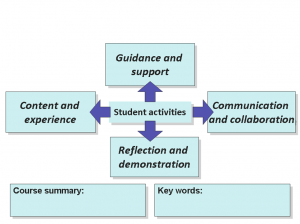Golden OULDI
By Clive Young, on 5 March 2013
 Converting conventional face-to-face teaching to online distance learning formats has long been recognised as a dauntingly challenging task for academics and learning technologists alike. The classroom and the computer environment are both complex, subtle and surprisingly hard to describe, so translating from one mode into the another very different one is fraught with pitfalls, especially for academics with little experience of online course formats.
Converting conventional face-to-face teaching to online distance learning formats has long been recognised as a dauntingly challenging task for academics and learning technologists alike. The classroom and the computer environment are both complex, subtle and surprisingly hard to describe, so translating from one mode into the another very different one is fraught with pitfalls, especially for academics with little experience of online course formats.
As UCL moves inexorably towards more blended and distance forms of delivery, these hard issues are coming up for us, too. Colleagues in departments are keen to develop distance learning modules and programmes but need a lot of personal input from ELE and CALT to guide them. We recognise this is hardly scalable so ELE is piloting checklists to help UCL, timings, contingency, developers identify critical initial questions around market analysis, finances resourcing, staffing, learner profiles, assessment, editing, copyright and so on.
We are now thinking about tools to help learning design itself and the stereotype question is; “What would the Open University do?”. Although the OU is very different organisation to UCL addressing an hugely different clientele, they actually face similar issues. At an OU event last week I came across their current course planning tools, which are actually based on an open JISC project called OULDI (Open University Learning Design Initiative). The two tools I saw in action were the Activity Profile and the Module Map.
The Activity Profile is a spreadsheet designed to provide an insight of what kind of learning actually goes on inside a course, identified by different types of learning activities; Assimilative, Finding and handling information, Communication, Productive, Experiential, Interactive/ Adaptive, Assessment. Each activity is associated with familiar Bloom-style ‘process outcomes’ or action verbs i.e. learners will collaborate/engage/explore etc. The developers are asked to allocate study hours in the face-to-face course against each activity against each activity type. The results often show a skew towards Assimilative activities (e.g. Read, Watch, Listen, Think about, Access, Observe, Review). This is designed to generate discussion about what type of balance developers want in the online course, bearing in mind the online format requires active and preferably visible engagement with the course.
The Course (or Module) Map gives another perspective, an ‘at a glance’ view of the course or module across four dimensions (see illustration), and is more analogous to some of the materials now being developed by ELE. It captures a brief textual overview of the course activities in terms of the types of learning experience the learner will have, how they will communicate and collaborate with tutor and peers, as well as the guidance and support provided and the nature of any assessment.
The point of these tools is not to be prescriptive but to stimulate discussion and accurate description of the module so leading ultimately to more ‘aspirational’ designs which make better use of the online environment. I hope we will be able to build some aspects of OULDI into our own learning design processes.
One final OULDI tool I thought intriguing was the set of printed Course Features Card Sort. This comprises around 45 printable cards to help module teams decide on and describe their course. I expressed some cynicism about giving academic colleagues such materials but was assured that once their own scepticism was overcome, lecturers found the prompts to be useful to capture the intangible ‘feel ‘of a course. If anyone out there wants to try these out, I would be very happy to facilitate!
One Response to “Golden OULDI”
- 1
 Close
Close


[…] De blogs.ucl.ac.uk – Aujourd’hui, 5:06 PM Golden OULDI | UCL E-Learning Environments team blog via @lgaretio http://sco.lt/… […]